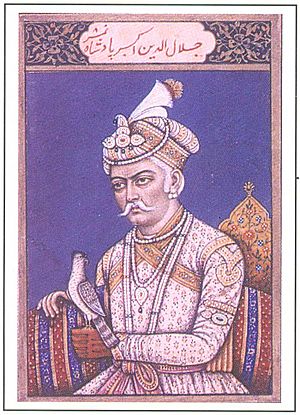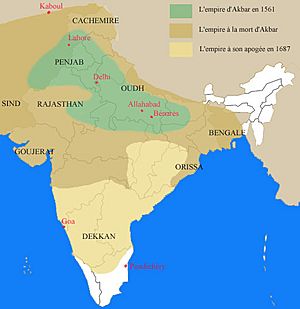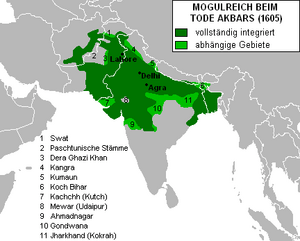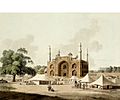Akbar the Great facts for kids
Akbar (born Abu'l-Fath Jalal ud-din Muhammad Akbar) was the third Mughal Emperor. He was born on October 14, 1542, in Umerkot (which is now in Pakistan). Akbar was the son of Humayun, the second Mughal Emperor.
Akbar became the official king in 1556 when he was just 13 years old, after his father passed away. Bairam Khan was chosen to rule for Akbar as his regent and lead his army. Soon after becoming emperor, Akbar defeated Himu, a general of the Afghan forces, in the Second Battle of Panipat. After a few years, he took full control of the kingdom from Bairam Khan.
Akbar first tried to make friends with the Rajputs, who were powerful Indian rulers. However, he had to fight some Rajputs who did not want to join him. In 1576, he defeated Maha Rana Pratap of Mewar in the Battle of Haldighati. Akbar's wars made the Mughal Empire much bigger. It grew to cover most of the Indian subcontinent, except for the very south.
Contents
How Akbar Ruled
Akbar had a very organized way of running his government. It was based on older systems but he made many improvements. He created clear rules for how different parts of the government should work.
- The revenue department handled all money matters. It was led by a wazir. This person was in charge of all finances and managing lands given to nobles.
- The military was led by the mir bakshi. This important noble was in charge of gathering information and suggesting people for army jobs.
- The mir saman looked after the royal household. This included the harems and making sure the court ran smoothly.
- The justice system was separate. It was led by a chief qazi. This person also looked after religious beliefs and practices.
Akbar's Religious Ideas
Akbar was a Muslim. He understood that to build a strong empire, he needed the trust of his Hindu people. Hindus were the majority in India at that time.
Akbar suggested a religious path called Din-i-ilahi. It was a set of moral rules that showed Akbar's ideas of fairness and peace. He wanted to bring unity and tolerance to his empire. Some ideas of Din-i-ilahi included believing in one God and being kind to all living things. It did not have special rituals, holy books, or temples.
Akbar was known as a fair and just emperor. He loved to learn about different religions. When he was at Fatehpur Sikri, he often held discussions with religious leaders. He noticed that people of different faiths were sometimes intolerant of each other. This led him to create the idea of Sulh-e-kul, which means universal peace. This idea taught that all religions should be respected. It focused on peace, unity, and tolerance for everyone. Because of this, Hindus and people of other faiths loved him.
Akbar's Personality
Akbar's life was written down by his court historian, Abul Fazal. His books were called Akbarnama and Ain-i-Akbari. Akbar was a very talented person. He was a skilled warrior, an artist, and a great administrator. He was also an inventor and good with animals. He became emperor at a young age.
The Nine Jewels
Akbar had nine special people in his court. They were called the Navaratnas or "nine jewels." These included famous people like Abul Fazal, Faizi, Tansen (a great musician), and Birbal (known for his wisdom). Other important jewels were Raja Todar Mal, Raja Man Singh, Abdul Rahim Khan-I-Khana, Fakir Aziao-Din, and Mullah Do Piazza.
The Akbarnama
The Akbarnāma means the Book of Akbar. It is the official story of Akbar's life. It was written by Abu'l-Fazl ibn Mubarak, one of Akbar's "Nine Jewels." The book gives very detailed descriptions of Akbar's life and times. It also tells about the plants, animals, and people of his reign. It even describes the places Akbar visited.
Akbar himself asked Abul Fazl to write this book. It took seven years to finish. The book also has beautiful illustrations done in the Mughal style of painting. A part of this work is called Ain-i-Akbari.
Akbar's Death
On October 3, 1605, Akbar became very ill with a serious sickness. He never recovered. Twelve days after his sixty-third birthday, he passed away on October 27, 1605. His body was buried in a grand tomb in Sikandra, near Agra. This place is known as Akbar's tomb.
Images for kids
-
Young Abdul Rahim Khan-I-Khana son of Bairam Khan being received by Akbar
-
Silver coin of Akbar with inscriptions of the Islamic declaration of faith.
-
Death of Bahadur Shah of Gujarat at Diu, in front of the Portuguese in 1537
-
Portuguese ambush against the galleys of Seydi Ali Reis (Akbar's allies) in the Indian Ocean.
-
The Akbari Mosque, overlooking the Ganges
-
The Mughal Emperor Akbar welcomes his son Prince Salim at Fatehpur Sikri.
-
Akbar triumphantly enters Surat
-
Akbar hunting with cheetahs, c. 1602
-
Abu'l-Fazl ibn Mubarak presenting Akbarnama to Akbar, Mughal miniature
-
Gate of Akbar's mausoleum at Sikandra, Agra, 1795
See also
 In Spanish: Akbar para niños
In Spanish: Akbar para niños





























